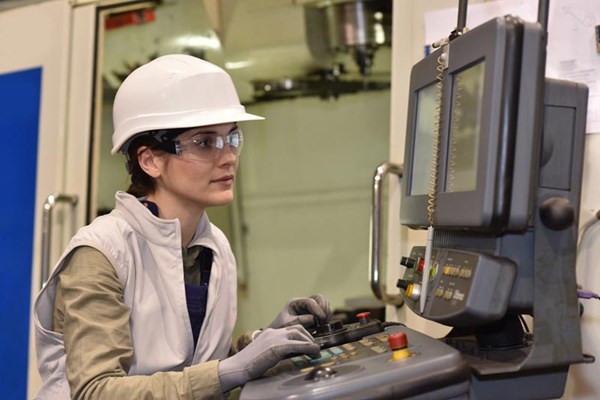For example, it's not considered common to see women carting wheelbarrows, using welding machines, or nail guns. And this stereotype is not limited to occupations on the ground, it's a problem that exists right throughout male-dominated industries such as agriculture, construction, manufacturing, mining, transportation, and utilities.
However, though it seems like a strange picture, women working within these workplaces isn't really anything new. During the Industrial Revolution, economics drove many women to work. It wasn't just textile factories and 'women's' work they conducted. They were also driven to work in mining, manufacturing, mills, and various other 'male-dominated' factories, which makes it quite surprising to learn that the gender divide is still so wide, and perhaps to the detriment of many industries, too.
Across multiple industries there are pressing challenges that need diverse perspectives in order to effectively address solutions. And according to Dr. Marlene Kanga, one of Australia's leading women engineers, "comprehensive international research shows that diverse organisations are more innovative and profitable.”
Benefits and Losses of Gender Diversity in the Workplace
Benefits of gender diversity include:
- Healthier workplaces
- Increased efficiency and effectiveness
- Inclusiveness
- Better governance
- Enhanced financial performance
- Improved safety
- Greater initiatives and innovations
Whereas, lack of diversity can lead to increased mental health issues across industries, something that appears to be growing across industrial sectors.
For example, the reported mental health rates in male-dominated industries are:
- Agriculture (1.3-17.3%)
- Construction (2.4-11%)
- Manufacturing (2.6-23.4%)
- Mining (19.3-28%)
- Transportation (2.5-13.3%)
- Utilities and manual workers (4.4-12.6%)
The Underrepresentation of Women
It is well noted that in general girls do better at school. Yet despite this, across both manual labour and in leadership roles, women are underrepresented and underpaid compared to men.
The Sydney Morning Herald reports electrical trades, crane operators and metal machinists as the most sexist jobs in terms of industry pay rates.
Catalyst reports that male-dominated industries employ 25% or fewer women.

Featured Image Credit: Catalyst Quick Take: Women in Male-Dominated Industries and Occupations in U.S. and Canada. New York: Catalyst, 2015.
And the underrepresentation of women in the workplace is not isolated to Australia, as you can see by the following percentage of women workers in the United States.

Featured Image Credit: OSHO.gov
As for overall employment (and underemployment) rates, the following statistics highlight the disparity.

Featured Image Credit: Gender composition of the workforce by industry via Australian Government

Featured Image Credit: Gender composition of the workforce: by industry via Australian Government
It should also be noted that in many other areas of corporate Australia, women have been securing more positions within leadership teams, yet industries where there still remain no women in corporate positions include mining, engineering firms, agricultural and manufacturing companies.
Workplace Stereotypes
It is a complex issue and in many cases the gender divide is not necessarily something that's been constructed on purpose. In general, though, it all comes back to workplace stereotypes, that idea of 'men's work' compared to 'women's work.' These factors are deeply embedded, not only within companies, but also within society as whole.
For example, role models, it is common for young people to admire leaders and use them as role models for their life's vision. Yet, within industrial sectors there have been very little women that have successfully navigated long-term careers and family life, making it difficult for young people to aspire to.
Construction, mining, and manufacturing are great industries with secure work and pay, often more regular work and at a higher pay rate than many other employment options. Yet many young women don't consider them as legitimate careers because of the stereotypes surrounding them and the fact they aren't encouraged into these roles during school.
Women Are More Than Capable
One example of this is Mia Savic, a 21 year old from Mount Pleasant, who says she was the only girl in the chemical engineering class. Despite the challenges Miss Savic faced, she is currently being groomed for selection as one of the youngest CEOs in the oil and gas sector.
Women are more than capable of many of the roles available in the industrial sector, many of them nominated for the Women in Industry awards, a yearly event to recognise women in mining, engineering, manufacturing, logistics and commercial road transport industries.
There are also worldwide forums such as the Women in Industry Forum that are highlighting the roles that women do (and can) play within the industrial sector. There are young women pursuing construction work and hundreds of notable women in the mining sector.
Without a doubt, there is a pool of female talent for industrial companies to tap into. Not to mention, there are alternative careers that women can pursue.
Resources to encourage gender diversity
- A wide range of 2016 Australian gender facts and statistics here.
- REPORT: A strategy for inclusiveness, well-being and diversity in engineering workplaces
- REPORT: Increasing the diversity of the mining industry workforce- strategies for employers
- REPORT: Workplace diversity industry snapshot 2013
- REPORT: How to set gender diversity targets








